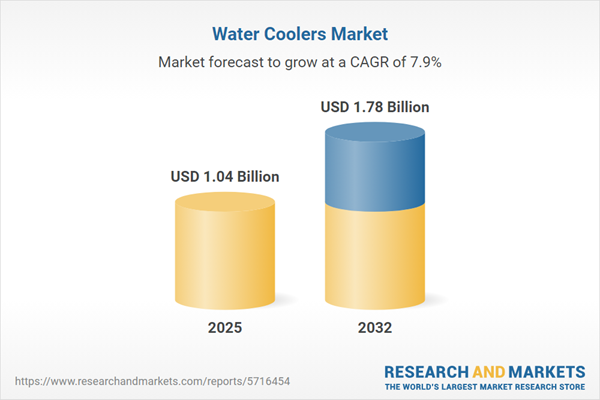Speak directly to the analyst to clarify any post sales queries you may have.
The water coolers market is transforming as organizations seek integrated hydration solutions that balance employee well-being, cost efficiency, and environmental responsibility. Evolving workplace standards and the need for compliance-ready infrastructure continue to shape strategic purchasing in this sector.
Market Snapshot: Water Coolers Market Trends & Growth
The global water coolers market reached USD 971.83 million in 2024, with expectations to grow steadily, supported by a projected CAGR of 7.86%. The expansion is underpinned by widespread adoption of advanced hydration technologies across commercial and residential settings. Innovations such as improved filtration systems and the integration of smart features are elevating water safety, creating operational efficiencies, and enabling digital monitoring capabilities. Leading suppliers are increasing R&D spending to address ever-changing environmental regulations, set new standards for product quality, and strengthen their competitive positioning. This ongoing modernization is reshaping buying patterns among businesses focused on employee well-being, compliance, and sustainability.
Scope & Segmentation of the Water Coolers Market
- Product Types: Bottled water coolers offer straightforward deployment and adhere to high hygiene standards, while point-of-use dispensers and reverse osmosis systems leverage current plumbing for continuous filtration. Ultraviolet-based models deliver consistent reliability for highly regulated environments where water quality is mission critical.
- End Users: Educational institutions, healthcare providers, hospitality venues, corporate offices, and retail spaces require solutions that withstand high traffic and comply with sector regulations. Residential users benefit from flexible and compact models that accommodate diverse household layouts and usage levels.
- Cooling Technologies: Compressor-driven models are suited to demanding, high-capacity applications and contribute to organizational sustainability targets. Thermoelectric units offer precise energy management, making them desirable for installations with targeted, smaller-scale requirements.
- Distribution Channels: Most purchases occur through direct sourcing and B2B distributors, although expanding retail and e-commerce platforms increase accessibility and support varied procurement strategies.
- Temperature Configurations: Organizations can select from ambient, cold-only, or hot-and-cold options to ensure hydration services are matched to the distinct requirements of each facility.
- Regions: Market adoption varies by geography, with the Americas, Europe, Middle East & Africa, and Asia-Pacific regions each characterized by unique regulatory standards, infrastructure development, and purchasing behaviors that inform product choices and rollout strategies.
- Key Market Players: Prominent names such as Primo Water Corporation, Culligan International Company LLC, Nestlé S.A., Waterlogic Limited, Hoshizaki Corporation, Bravilor Bonamat B.V., Oasis International LLC, Elkay Manufacturing Company, Avalon H2O LLC, and Vivreau Limited continue to drive advancements and shape sector standards.
Key Takeaways for Senior Decision-Makers
- Advanced filtration and integrated digital monitoring support comprehensive management of water quality, enabling organizations to align with both internal standards and evolving external regulations.
- Procurement strategies now reflect nuanced requirements for sectors with high daily usage and intensive compliance needs, such as healthcare, education, and residential environments.
- Energy-efficient and sustainable product designs coordinate with enterprise sustainability goals and demonstrate commitment to responsible operations.
- Organizations gain supply chain flexibility and resilience by leveraging omnichannel procurement, minimizing vulnerability to disruptions and enabling quick responses to market shifts.
- Lifecycle management initiatives and active compliance monitoring foster continuous improvement, ensuring readiness for emerging best practices and regulatory updates.
Tariff Impact and Supply Chain Adjustments
Recent changes in U.S. tariff policy have prompted organizations to adjust sourcing strategies, with an increased emphasis on domestic manufacturing and diversified supplier bases. These actions aim to contain costs, stabilize supply chains, and reduce exposure to fluctuating trade environments.
Methodology & Data Sources
This report draws on a comprehensive mix of B2B market research methodologies, including executive interviews, targeted surveys, regulatory reviews, and global patent analysis. Each market segment is rigorously analyzed to deliver actionable intelligence aligned with executive decision-making needs.
Why This Report Matters
- Presents guidance anchored in current market trends, procurement innovations, and regulatory shifts, giving senior leaders clear direction for forward-looking strategies in the water coolers market.
- Empowers executives to refine product planning and build more resilient, compliant supply chains for operational sustainability.
- Offers risk assessments and sector-specific insights that support informed, evidence-based decision-making.
Water Coolers Market: Insights for Leaders
These research findings equip senior decision-makers with the knowledge to optimize organizational hydration strategies, prioritize technology investment, and sustain business adaptability within a dynamic market landscape.
Conclusion
Integrating these insights enables organizations to enhance hydration initiatives, maximize returns on investment, and strengthen sustainability outcomes across workplace environments in the water coolers sector.
Additional Product Information:
- Purchase of this report includes 1 year online access with quarterly updates.
- This report can be updated on request. Please contact our Customer Experience team using the Ask a Question widget on our website.
Table of Contents
3. Executive Summary
4. Market Overview
7. Cumulative Impact of Artificial Intelligence 2025
Companies Mentioned
The companies profiled in this Water Coolers market report include:- Primo Water Corporation
- Culligan International Company LLC
- Nestlé S.A.
- Waterlogic Limited
- Hoshizaki Corporation
- Bravilor Bonamat B.V.
- Oasis International, LLC
- Elkay Manufacturing Company
- Avalon H2O, LLC
- Vivreau Limited
Table Information
| Report Attribute | Details |
|---|---|
| No. of Pages | 193 |
| Published | October 2025 |
| Forecast Period | 2025 - 2032 |
| Estimated Market Value ( USD | $ 1.04 Billion |
| Forecasted Market Value ( USD | $ 1.78 Billion |
| Compound Annual Growth Rate | 7.8% |
| Regions Covered | Global |
| No. of Companies Mentioned | 11 |









